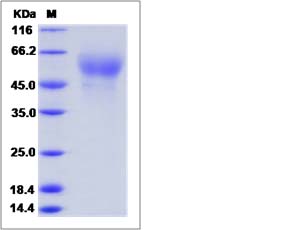Human CD155 / PVR / NECL5 Protein
CD155,HVED,Necl-5,NECL5,PVS,TAGE4
- 100ug (NPP1118) Please inquiry
| Catalog Number | P10109-HCCH |
|---|---|
| Organism Species | Human |
| Host | Human Cells |
| Synonyms | CD155,HVED,Necl-5,NECL5,PVS,TAGE4 |
| Molecular Weight | The recombinant human CD155 is a monomeric protein after proteilytic removal of the signal peptide. It consists of 329 amino acids and predicts a molecular mass of 35.7 kDa. As a result of glycosylation, the appqrent molecular mass of rhCD155 is approximately 55-60 kDa in SDS-PAGE under reducing conditions. |
| predicted N | Leu 18 |
| SDS-PAGE |  |
| Purity | > 95 % as determined by SDS-PAGE |
| Protein Construction | The mature form of the extracellular domain (Met 1-Asn 343) of human CD155 (NP_006496.3) was expressed and purified, with additional five amino acids (DDDDK) at the C-terminus. |
| Bio-activity | Measure by its ability to bind with recombinant human DNAM1 / CD226 . |
| Research Area | Immunology |Innate Immunity |Monocytes/Macrophages |Monocyte Markers |
| Formulation | Lyophilized from sterile 50mM Tris, 100mM NaCl, pH 8.0 1. Normally 5 % - 8 % trehalose and mannitol are added as protectants before lyophilization. Specific concentrations are included in the hardcopy of COA. |
| Background | CD155, commonly known as PVR (poliovirus receptor) and Necl-5 (nectin-like molecule-5), is a type I transmembrane single-span glycoprotein, and belongs to the nectins and nectin-like (Necl) subfamily. CD155 was originally identified based on its ability to mediate the cell attachment and entry of poliovirus (PV), an etiologic agent of the central nervous system disease poliomyelitis. The normal cellular function is in the establishment of intercellular adherens junctions between epithelial cells. CD155 may assist in an efficient humoral immune response generated within the intestinal immune system. It has been demonstrated that CD155 can be recognized and bond by DNAM-1 and CD96 which promote the adhension, migration and NK-cell killing, and thus efficiently prime cell-mediated tumor-specific immunity. |
| Reference |
